Pasture for Life continues to attract new farmer members as interest from consumers looking for high nature-value,
nutrient-dense meat and dairy grows every day. Here two farmers explain how being Pasture for Life certified has
contributed to their success. Sara Gregson reports
Nicola Chapman, Carr Farm, Suffolk
Twenty Belted Galloway cows with their calves, all with their distinct, thick white band around the centre of their bodies, graze peacefully on the marshes at the bottom of Nicola and David Chapman’s 40-hectare farm, at Burgh St Peter on the Suffolk/Norfolk border.
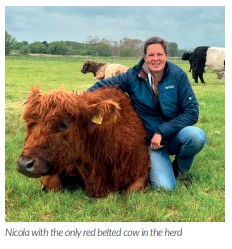
The Chapmans arrived at Carr Farm in 2011, from a smallholding in Diss. Originally, the land had an agricultural tenant, but has now been taken back in hand. Half comprises drained marshes of the River Waveney and the rest is higher land of light sandy, gravel soils. “David and I were both working full time to start – David with the NHS in Norwich and me as a surveyor,” Nicola explains. “I gave up completely two years ago and David is now down to working three days a week, so we are gradually finding more time to do the things we want to on the farm.”

The Chapmans carry out low impact farming, encouraging all elements of nature and wildlife to flourish alongside the production of prime beef. The pedigree Waveney Herd graze extensively at home and on a further 49 hectares across several parcels of land, mainly belonging to the Suffolk Wildlife Trust, but also some reserves in private hands.
“I always knew I wanted to have cattle,” says Nicola. “After we bought the farm, we reverted the arable fields into grass and then had to decide which breed of cattle we wanted. “With no barn then for winter accommodation, we were looking for hardy, native cattle that were not too big but that produced fine meat to eat. Belted Galloways fitted the bill perfectly.
The Chapmans sourced their first five pedigree heifers with help from the Belted Galloway Pedigree Cattle Society in 2014. Now there are 80 animals in total, including the cows and calves, yearlings, breeding youngstock and finishing animals.
“The steers mature very slowly, eating nothing but the grasses and plants that grow out on the marshes. Nothing leaves here under 30 months of age and it is this that gives the meat its incredible texture and flavour,” says Nicola.
The cows overwinter on the freedraining sandy land behind the farm house and are supplemented with large hay bales made from the marshes the previous summer. In April the grazing agreements start and the yearlings go to the furthest sites, including Carlton and Oulton Marshes. The cows mainly calve from early April for two months and calve easily and without assistance. A few of the older mothers are now more than ten years old.
Pasture for Life
“We joined Pasture for Life straight away and became certified,” explains Nicola. “This means we can use the Pasture for Life logo on our beef packs which is the only 100% grass-fed guarantee. “A third of our customers buy our meat for health reasons because they cannot eat meat from animals that have been fed grain or soya. Another third are local customers who buy because they love to see the Belties grazing on the marshes – there is a real connection.
“Direct selling is hard work and I spend a lot of time being a retailer and promoting our beef on social media. We have built up a loyal list of customers who we email when a beast is ready. “But there are signs of more interest coming now from butchers and restaurants, as the benefits of farming in a more regenerative way become more widely recognised.”
Anna Blumfield, Deersbrook Farm, Essex
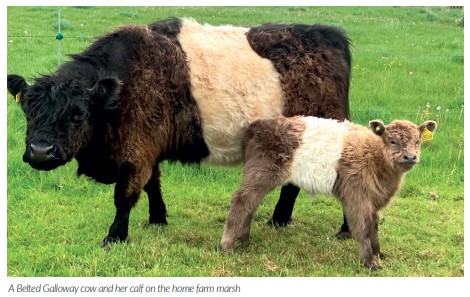
Anna Blumfield and her husband Phil started a grass-fed only herd of Sussex cattle alongside her parents intensive cattle rearing and fattening unit, near Braintree in Essex in 2015. She always knew she wanted to sell her meat direct to the public and setting up the new herd was the way she saw to do this.
“After lots of research we knew we wanted to go down the 100% Pasture for Life way of farming and we knew the Sussex breed would absolutely thrive on this type of system,” Anna explains.
A total of 190 head of cattle – including 115 suckler cows, now graze 41 hectares of grassland at the home farm, as well as a further 278 rented hectares on grazing agreements, including Natural England heritage sites and some around some MOD airbases.
“Throughout their lifetime our cattle graze different biodiverse pastures filled with clovers and herbs,” says Anna. “They also browse the hedgerows and trees which means they can access all the nutrients they need.
The cattle spend spring, summer and autumn grazing and come into strawbedded barns in November and fed just hay, silage and minerals. Muck from the winter barns is composted and applied back to the home fields.
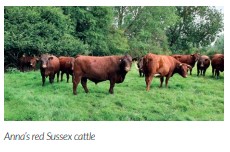
Most of Anna’s grass-fed cattle finish at 26 to 29 months of age at 300 to 350kg deadweight and grade at an average conformation score of R4L. Anna started selling her meat at farmers’ markets and from a small shop on the farmyard at home. In 2018 she opened a new butchery and shop, giving her more control over how individual carcasses were broken down and presented.
“We’ve built a really solid customer base, and are now selling a full carcase every week,” says Anna. “Customers range from locals who pick up their regular staples, to those who come from further away, many aware of the nutritional advantages of 100% grassfed beef and buy all kinds of cuts to fill their freezers.”
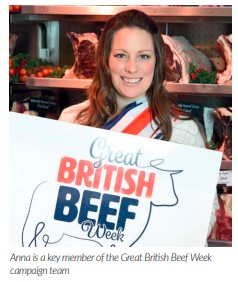
Anna was one of the first beef farmers to become Pasture for Life certified in the country.
“Being Pasture for Life certified is fundamental to our business because it encompasses everything we believe in – the ethos of regenerative farming, working with the ruminant’s natural digestive system, and farming to benefit the environment, wildlife and water systems as well,” says Anna. “It really is all encompassing to what we believe farming should be.
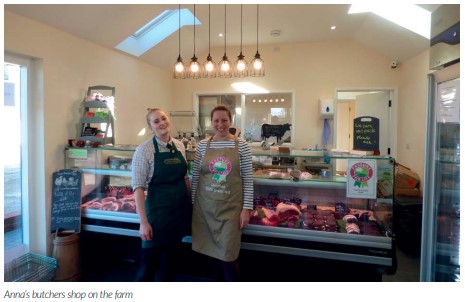
“I’ve been lucky enough to attend lots of Pasture for Life tasting events supplying cuts of our beef and talking about how we look after the animals to consumers. I have also taken every opportunity to promote the principles of 100% grass-fed beef production on national and local radio and national TV, including Saturday Kitchen and Newsnight.
“Pasture for Life has really supported us over the years, and this, with the certification has given our customers trust in the product they are buying from us. It’s been a fantastic journey so far and long may it continue!”

Pasture for Life launches new visual identity
The Pasture-Fed Livestock Association has announced it is to be known as ‘Pasture for Life’ from now on and has launched a new logo and visual identity. The past two years has seen growing numbers of consumers looking for livestock products that come with high environmental, ethical and health credentials. This has prompted the organisation to refresh the way it communicates to drive greater awareness of high nature-value farming. The move, which coincides with Pasture for Life’s 11th birthday, marks a significant moment for the organisation, which has grown from a few farmers back in 2011, to a diverse group of farmers, butchers, dairies, artisan food producers, chefs, nutritionists, academics, students, storytellers and many more. Membership now stands at more than 800.
“We have refreshed our visual identity and our core messages to better reflect the benefits of 100% pasture-fed farming,” says Pasture for Life Executive Director Jimmy Woodrow. “We hope this will help our farmers communicate the benefits of the way they farm and help shoppers find and understand the health, welfare and environmental advantages of buying Pasture for Life certified food and fibre.”
In addition to the new visual identity, Pasture for Life also launched a short film to mark its first ten years, which can be viewed on the Pasture for Life YouTube channel.